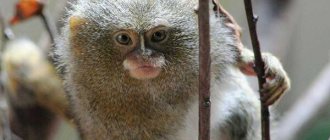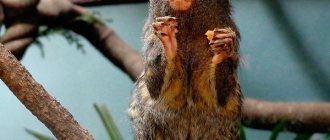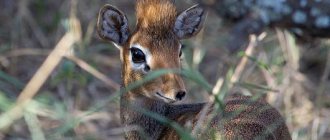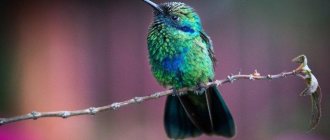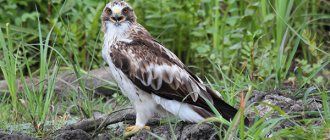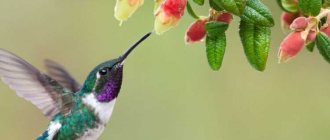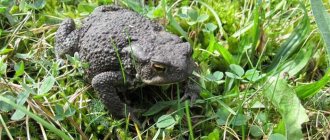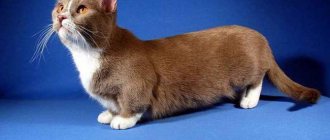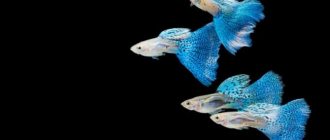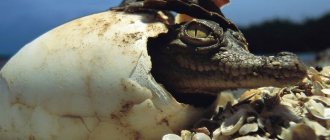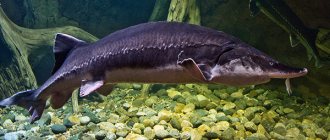The Bee Hummingbird is of great interest, because this particular bird is the smallest in the world: its length does not exceed five centimeters, from its beak to its tail. Therefore, it can easily be confused with an insect.
Since for a comfortable existence the bird needs a wooded area rich in plants, such as lianas, its habitat is the island of Cuba and the nearby peninsulas. In this article we will look at the features and individual characteristics of this miniature bird, as well as its breeding season, breeding and fertilization period.
Description of the Bee Hummingbird
Male bee hummingbirds have very bright plumage during the breeding season, while females are traditionally duller in color. In addition, differences between the opposite sexes are observed in size - males are significantly smaller than females.
From the tip of the beak to the tail, the size of the bee hummingbird is 5-6 centimeters, and its weight does not exceed 1.6-1.9 grams.
Due to their small size, Cuban hummingbirds are often confused with moths, as these moths are also able to hover in front of a flower while feeding on nectar.
Bee hummingbird (Mellisuga helenae).
Green Warbler
The miniature green warbler reaches 10 cm in length and weighs about 8 grams. A singing insectivorous bird, it lives in coniferous and mixed forests of Eurasia from Europe to the Pacific coast. Winters in India. The green warbler has an olive-green back, a gray-white belly with a yellowish tint, and brown legs. You can distinguish the bird by a yellow stripe above its eyes, resembling an eyebrow.
Male and female green warblers are generally similar
Diet of hummingbird-bees
These crumbs feed on the nectar of a variety of fragrant flowers, shrubs, herbs and trees. One individual collects nectar from an average of 1,500 flowers per day. They prefer flowers with a high concentration of sucrose - at least 15-30%. That is why they love solandra most of all, which is also called the Cup of Wine or the Cup of Golden Wine.
While sucking nectar, the bee hummingbird literally hovers in flight above the flower.
Bee hummingbirds have a high metabolism, so they need a lot of food. These little ones eat most of the day, and the daily serving size is equal to half of their body weight. They also have to drink a lot - the volume of drink exceeds their body weight by 8 times. This is comparable to the fact that a person weighing 50 kilograms would need 400 liters of water daily.
But hummingbirds feed on more than just nectar. During the mating season, they eat small insects, as they need protein at this time.
Notes
- Boehme R. L., Flint V. E.
Five-language dictionary of animal names. Birds. Latin, Russian, English, German, French / Under the general editorship of academician. V. E. Sokolova. - M.: Rus. lang., "RUSSO", 1994. - P. 165. - 2030 copies. — ISBN 5-200-00643-0. - [ibc.lynxeds.com/species/bee-hummingbird-mellisuga-helenae Internet Bird Collection Bee Hummingbird]
- Bo Dalsgaard, Daniel W. Carstensen, Arturo Kirkconnell, Ana M. Martín González, Orestes Martínez García, Allan Timmermann, & William J. Sutherland
[sora.unm.edu/sites/default/files/ON%2023%281%29% 20143-149.pdf Floral traits of plants visited by the bee hummingbird (
Mellisuga helenae
] // Ornitologia Neotropical. - 2012. - Vol. 23, No. 1. - P. 143-149.
Reproduction of Cuban hummingbirds
Hummingbirds lead a solitary lifestyle, and they form pairs only for a short time to continue the race.
The average weight of one bird is less than 1.6 g.
The hummingbird's mating season occurs at the end of the rainy season or at the beginning of the dry season, since many shrubs and trees bloom at this time.
Males gather in groups in special places and make monotonous chirping and squeaking sounds. With this singing they attract females. The female chooses a mate from the general chorus. Hummingbird pairs are fragile, and mature males can fertilize several females at once. Also, one female can have several partners.
The female builds a cup-shaped nest by weaving together blades of grass, moss, cobwebs, lichens and animal hair. Initially, the diameter of the nest is 2.5-3 centimeters, but since it is built from flexible materials, as the chicks grow, it can be increased almost 2 times. The nest is located on a tree branch, at a height of 1-6 meters from the ground.
Immediately after mating, the pair separates. Males do not help females build nests, hatch eggs and raise offspring.
The clutch contains 2 white eggs the size of a pea, their diameter does not exceed 6 millimeters. After about 16 days, the chicks hatch. They are immobile, blind and have no down.
The female protects her babies from danger and feeds them with regurgitated insects, since nectar contains little protein and is not enough for the development of the babies. The mother pushes food directly into the chicks' stomachs with her long beak.
The breaks between feeding the babies should not exceed 8 minutes, otherwise the chicks weaken and fall into torpor, and then, in general, may die. After 18-38 days, the hummingbird-bee chicks fly out of the nest. They reach sexual maturity a year after birth.
A mother hummingbird should feed her babies at least every 7-8 minutes.
Banana Warbler
The length of the banana warbler is approximately 11 centimeters. This bird lives in the tropics of Central and South America. Another name is sugar bird or sugar bowl, apparently because of its love for sweets: the warbler does not disdain berries, although the basis of its diet is flower nectar and insects. The appearance of the banana warbler is memorable - gray back, yellow chest and belly, black cap on the head, beak curved down.
Unlike most birds, the male and female banana warbler look the same
Hummingbird-bee species status
Currently, these tiny creatures are found only on the island of Cuba, but previously they were found on the neighboring islands of Santo Domingo, Jamaica and Haiti. They lead a sedentary lifestyle and make minor feeding migrations only when necessary.
Bee hummingbirds are an endangered species. In nature, the enemies of these little ones are birds of prey, mongooses, rats, fish, frogs and large spiders. But these predators cannot cause serious damage to the population. People are cutting down forests and draining swamps to grow coffee, tobacco and cocoa, leading to serious environmental problems.
The main reason for the extinction of the hummingbird-bee species is the destruction of their habitat.
King's finch
Although the body length of the king finch can reach 14 centimeters, the average value is considered to be 11–12. The color of the bird is interesting - a combination of black, brown, yellow and red tones. Due to the characteristic red spot on the head, this finch is also called the red-capped finch.
The king finch is a songbird. Lives in Asian countries and the Caucasus. It feeds exclusively on seeds.
The male and female king finch look similar, but the female is not as brightly colored
Interesting facts about Cuban hummingbirds
• The Bee Hummingbird is not only the tiniest bird, but also the smallest warm-blooded animal on the planet; • These birds have the smallest number of feathers compared to other birds; • Hovering in front of a flower, the bee hummingbird manages to make 90 wing beats per second; • The Bee Hummingbird holds the record for heart rate. When the hummingbird is in a calm state, the heart makes 300 beats per minute, and when the bird is active - 500 beats per minute; • The Cuban hummingbird has the highest body temperature among birds, it is 40 degrees Celsius, and at night it drops to 19 degrees, this allows you to accumulate energy for the next active day; • Bee hummingbirds exhibit territorial behavior; they actively defend their areas not only from other hummingbirds, but even from insects: hawk moths and bumblebees. They intimidate enemies with the help of a special aerial demonstration.
If you find an error, please select a piece of text and press Ctrl+Enter.
This is interesting
Few people have the opportunity to see live birds of this species. But in the photo you can clearly see and get to know these amazing and wonderful miniature creatures.
- The bee hummingbird pollinates up to 1,500 flowers per day.
- This bird can fly at speeds of up to 50 km per hour.
- Hummingbird bees live solitary lives and never migrate.
- This is the most warm-blooded creature on the planet.
- These birds are prey to praying mantises, frogs and dragonflies.
- They live for about 7 years, and in captivity - up to 10 years.
Wren (9 cm)
The wren is half the size of house sparrows, grows up to 9 cm long, weighing no more than 12 g. The only representative of the family. Males sing like canaries, in a wide sound range. Females emit loud, monotonous trills. Soft lumps live in the middle latitudes of America, Eurasia, and North Africa. A distinctive feature of the birds is their small tail sticking up; it does not change position during the fussy movements of the birds.
During the day, small birds prefer to stay alone or in pairs; at night they settle in groups at the roots of trees, warming each other. Wrens nest in loose soil or on the ground in the form of a hemisphere, and line the surface with moss. Birds feed on insects, arachnids, and invertebrates. In the cold season, they switch to plant food: grass seeds, tree seeds, berries. The wren is located in the middle of the list of the smallest birds in the world.
Links[edit]
- BirdLife International (2016). "Mellisuga helenae" IUCN Red List of Threatened Species
.
2016
. DOI: 10.2305/IUCN.UK.2016-3.RLTS.T22688214A93187682.en.CS1 maint: uses the authors parameter (link) - ^ abcde Simon, Matt (July 10, 2015). "Absurd creature of the week: World's tiniest bird weighs less than ten cents". Wired. Retrieved March 8, 2022.
- ^ a b Dalsgaard, V; Martin Gonzalez, AM; Olesen, J.M.; Ollerton, J; Timmermann, A; Andersen, L.H.; Tossas, A. G. (2009). "Plant-hummingbird interactions in the West Indies: gradients of floral specialization related to environment and hummingbird size". Oecologia
.
159
(4):757–66. DOI: 10.1007/s00442-008-1255-z. PMID 19132403. - ^ a b Adrienne Glick. "Mellisuga helenae". Animal Diversity Network
. Retrieved June 19, 2022. - T. S. Schulenberg, ed. (2010). "Bee Hummingbird, Mellisuga helenae". Ithaca, NY: Neotropical Birds Online, Cornell University Lab of Ornithology. Retrieved March 8, 2022.
- Piper, Ross (2007). Unusual Animals: An Encyclopedia of Curious and Unusual Animals." Greenwood Press. paragraph 114. ISBN 978-0313339226.
- Dalsgaard, Bo et al. "Floral characteristics of plants visited by the bee hummingbird (Mellisuga helenae)." Ornithology Neotropical
23.1 (2012): 143–149. - Ibarra, Elena. "Bird survey in the Mogote plant complex in the Sierra del Infierno, Pinar del Rio, Cuba, June 2000." El Pitirre
: 7. - Jump up
↑ Navarro, Nils (2015).
Endemic birds of Cuba. Complete Guide
. Ediciones Nuevos Mundos. pp. 56–57. ISBN 978-0-9909419-1-0. - ^ a b Martinez Garcia, Orestes; Bacallao Mesa, Loraiza; Nieves Lorenzo, Elio (1998). “Estudio Preliminar de l Conducta reproductiva de hummingbird helenae (Aves, Swift-shaped) en condiciones naturales” [Preliminary study of the reproductive behavior of the hummingbird helenae
(Aves, Swift-shaped) in natural conditions].
El Pitirre
(in Spanish) (winter): 102–106. - Clark, Christopher J.; McGuire, Jimmy A.; Bonaccorso, Elisa; Burve, Jacob S.; Prum, Richard O. (2018). "Complex coevolution of wings, tails, and calls of courting male hummingbirds". Evolution
.
72
(3):630–646. DOI: 10.1111/evo.13432. ISSN 1558-5646. PMID 29380351.
